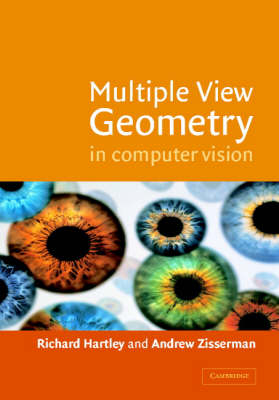
Multiple View Geometry in Computer Vision
Cambridge University Press (Verlag)
978-0-521-62304-9 (ISBN)
- Titel erscheint in neuer Auflage
- Artikel merken
A basic problem in computer vision is to understand the structure of a real world scene given several images of it. Techniques used in the book for solving this are taken from projective geometry and photogrammetry. The authors cover the geometric principles and their algebraic representation in terms of camera projection matrices, the fundamental matrix and the trifocal tensor. The theory and methods of computation of these entities are discussed with real examples, as is their use in the reconstruction of scenes from multiple images. Recent major developments in the theory and practice of scene reconstruction are described in detail in a unified framework. The authors provide comprehensive background material, so a reader familiar with linear algebra and basic numerical methods will be able to understand the projective geometry and estimation algorithms presented, and implement the algorithms directly from the book.
Introduction; Part I. The Background: Projective Geometry, Transformations and Estimation: 1. Outline of Part I; 2. Projective geometry and transformations of 2D; 3. Projective geometry and transformations of 3D; 4. Estimation – 2D projective transforms; Part II. Camera Geometry and Single View Geometry: 6. Outline of Part II; 6. Camera models; 7. Camera calibration; 8. More single view geometry; Part III. Two View Geometry: 9. Outline of Part III; 10. Epipolar geometry and the fundamental matrix; 11. 3D reconstruction and structure computations; 12. Computation of F; 13. Structure computation; 14. The case of planes; 15. Affine epipolar geometry; Part IV. Three View Geometry: 16. Outline of Part IV; 17. The trifocal tensor; 18. Computation of T; Part V. N View Geometry: 19. Outline of Part V; 20. N-linearities; 21. Computation of the quadrifocal tensor; 22. N-view computational methods; 23. Chirality; 24. Degenerate configurations; 25. Auto-calibration; 26. Image rectification; Appendix 1. Useful formulas; Appendix 2. Tensor notation; Appendix 3. Gaussian (normal) and chi-squared distributions; Appendix 4. Numerical algorithms; Bibliography; Index.
| Erscheint lt. Verlag | 31.7.2000 |
|---|---|
| Zusatzinfo | Worked examples or Exercises; 24 Tables, unspecified; 13 Plates, color |
| Verlagsort | Cambridge |
| Sprache | englisch |
| Maße | 182 x 256 mm |
| Gewicht | 1414 g |
| Themenwelt | Informatik ► Theorie / Studium ► Künstliche Intelligenz / Robotik |
| Mathematik / Informatik ► Mathematik ► Geometrie / Topologie | |
| ISBN-10 | 0-521-62304-9 / 0521623049 |
| ISBN-13 | 978-0-521-62304-9 / 9780521623049 |
| Zustand | Neuware |
| Haben Sie eine Frage zum Produkt? |
aus dem Bereich



